Live Tides
NOTICES TO MARINERS
Charts & Surveys

Incident reporting
Life-threatening emergencies on the river:
Call 999 and ask for the Coastguard
For near miss, safety observations and incident reporting click below
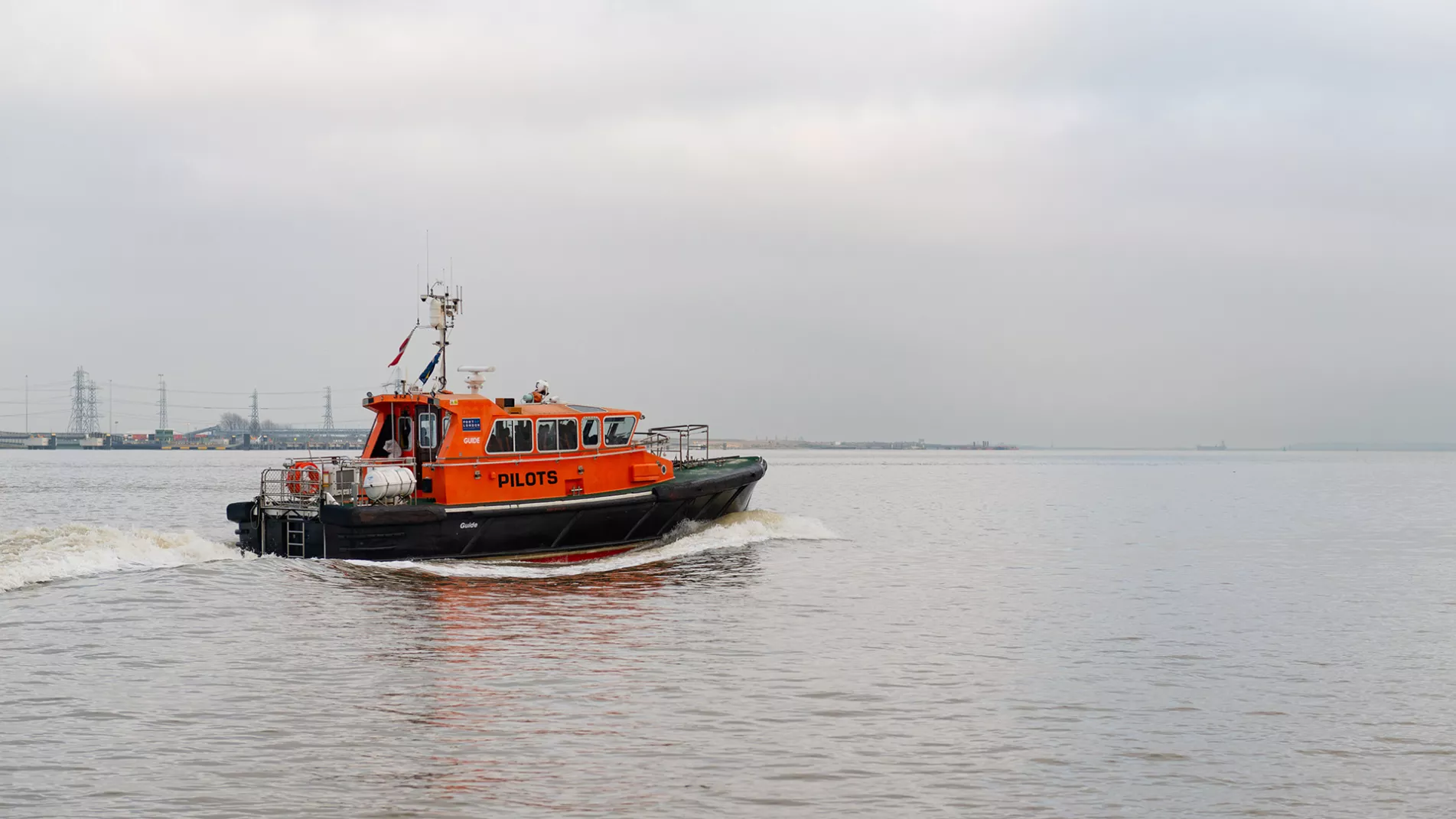
Our boats
Harbour Service vessels
The PLA maintains an active presence on the tideway with regular patrols by Harbour Patrol Launches between Southend and Putney (the "Lower" and "Middle" PLA districts). Special events and large ships requiring escort are also provided for by these vessels.
The area between Putney and Teddington (the "Upper District") is also patrolled daily, using two special launches for River Patrol, designed to serve the leisure community. Reserve launches are maintained to be available at short notice for special duties such as local traffic control and Thames Barrier closure patrols.
Chelsea and Richmond
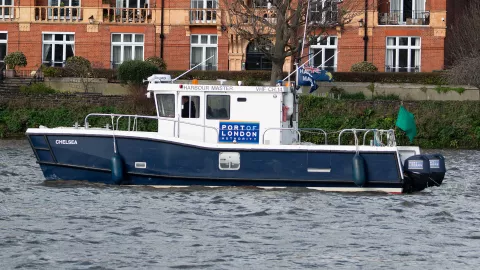
These vessels were built by Ecocats Limited in 2006/07, for use in the PLA's Upper District, following a three-year research programme into wash characteristics in shallow water carried out by the PLA and Southampton University.
The overall length of 10 metres and beam of just under 4 metres gives a large open platform and a spacious island wheelhouse from which the river patrol can provide ready assistance and guidance to rowers, canoeists and other small boat operators. The narrow-beamed hulls and light displacement (3.9 tonnes) cause the least possible resistance, which substantially reduces the power required to achieve normal patrol and emergency response speeds. Due to the vessel's low resistance, the twin Yanmar 36hp diesel outboards provide power for 17 knots, but offer a substantial 67% fuel saving when compared with the former Upper District patrol launches. This fuel economy, together with the solar panels provided to supplement electrical systems onboard, offer savings not only in operating costs but also in emissions of CO2.
Lambeth, Kew, Southwark & Barnes
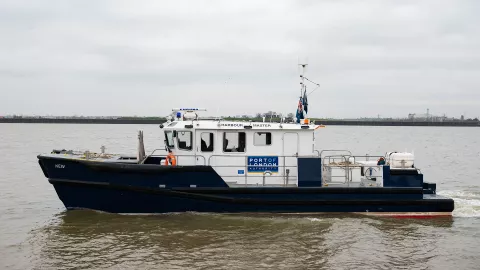
A fleet of four purpose-built harbour patrol vessels used in the middle and lower districts of the tidal Thames, between Putney Bridge and the North Sea.
The launches were built by Alnmaritec, based in Alnwick, Northumberland, and the hull type is aluminium catamaran with deep vee hull form, designed by Newcastle University The hull structure was designed by Amgram Limited. The vessels are 13.5 metres long and 4.8 metres wide with a weight of 11 tonnes. Two John Deere 200 horsepower marine diesel engines provide a maximum speed of 21 knots (24 mph) and a patrol speed of 18 knots (20.5 mph) in the lower districts of the tidal Thames.
Easthaven
Easthaven is a Powercat 525, shallow-draught RIB used mainly by the Harbour Service in the lower reaches of the Thames to patrol the Holehaven area.
She was built and supplied by Cornwall-based boat building company Multimarine Composites Ltd.
Crane
Crane is a sister vessel to Easthaven and was originally obtained to cover operational duties around the Queen's Diamond Jubilee Pageant in 2012.
Now located at Richmond, the vessel provides additional shallow-draught capabilities up river.
Marine Services vessels
PLA Marine Services, based at Denton Wharf, Gravesend, operate a wide range of vessels for the diverse range of operational requirements on the River.
These include Driftwood craft, used for clearing debris and for maintenance of moorings, Salvage craft, for clearing wrecks and obstructions, and the TOSCA vessels operated for the Thames Oil Spill Clearance Association.
London Titan
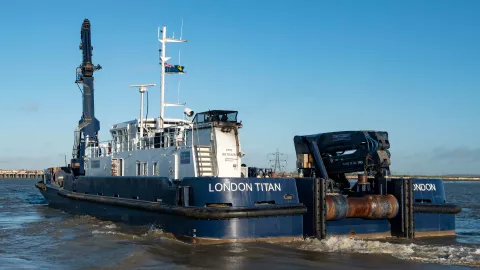
London Titan is our £7 million mooring maintenance vessel.
London Titan is specially designed to work along virtually all of 95 miles of the Thames we look after. She is squat and shallow enough to negotiate bridges as far upriver as Richmond, and robust enough to operate in the outer estuary.
Titan’s duties include: mooring maintenance; laying and recovering navigation buoys; hauling wreckage from the riverbed; supporting diving operations; and small scale plough dredging operations.
Driftwood II & Driftwood III
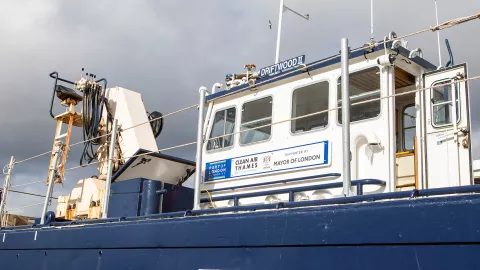
The Driftwood craft were built by Delta Shipyard for the PLA in 1989 and 1990 respectively.
Powered by twin Caterpillar 3306 DITA engines giving 235 bhp, they are capable of a maximum speed of 8 knots. Each is 14.4m in length, with a draught of 1.35m and displacement of 62 tonnes. Their main function is the collection of driftwood and other debris from the River but they are also equipped with hydraulic cranes, burning gear and salvage pumps.
Each craft is accompanied by a Dory tender, capable of 25 knots.
Gunfleet
A bespoke 850 open deck RIB built for the PLA by Redbay Boats in 2012.
Gunfleet is powered by a Yanmar 6LP with a Hamilton waterjet.
Benfleet
A bespoke RIB built for the PLA by Redbay Boats. Principally used as a crew transfer vessel on the Thames.
Powered by a Yanmar 6LP, propelled by the Mercruise Bravo 3 stern-drive. Benfleet is fitted with a pilot/wheel house and is licensed to carry 10 people. The design process was led by the PLA engineering team and the craft is tailored to the our needs, with a level of systems and outfitting rarely found on a RIB hull.
Recover
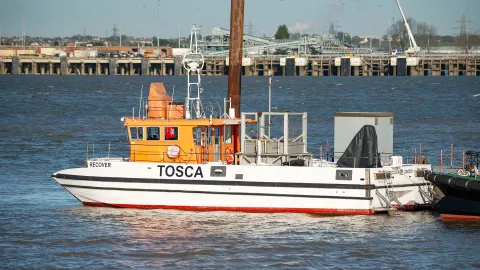
This TOSCA vessel was built by Prout Catermarans of Essex on a 'Panther 61' hull of 16.5m.
Twin Caterpillar 3406E engines each give 700 bhp and a top speed of 21 knots.
This unique vessel carries a Lamor brush pack system for collecting oil from the surface of water.
Respond
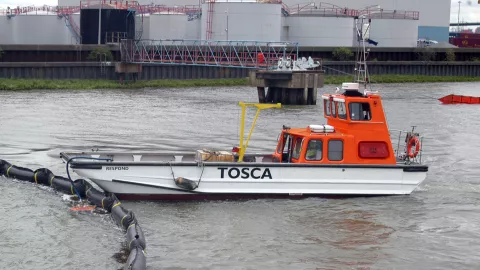
This second TOSCA vessel was built by RTK Marine Ltd of Poole.
12.7m long, with a draught of 0.5m, she is powered by twin Volvo Penta AD/41 DP engines giving 165 bhp through outboard drives and a maximum speed of 25 knots. The vessel is equipped with a bow ramp and heavily constructed underwater hull to allow beach landings for oil clearance purposes.
Impulse
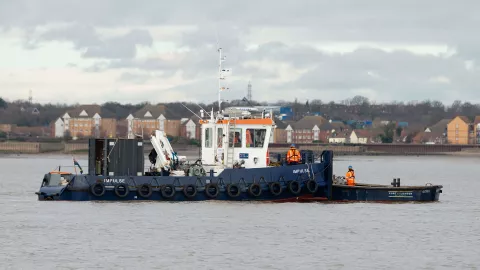
Impulse is a steel pusher tug built in 1994 by David Abels of Bristol.
Powered by twin Caterpillar 3306D engines of 235 bhp, the vessel is 14m in length with a draught of 1.5m and displaces 40 tonnes.
Used for a wide variety of driftwood and other tasks, she is equipped with a hydraulic crane and salvage pump.
Hydrographic Surveying vessels
The PLA Hydrographic Service undertakes regular surveys of all the main channels, providing vital information on depths and tidal data, as well as locating and marking any sunken obstructions.
Maplin

Maplin is an 18m catamaran built for us in 2015 by C-Truk in Colchester and Brightlingsea, Essex.
Entering service in 2016, Maplin has a resin-infused composite construction keeping it light, robust and efficient. Its low-profile wheelhouse and foldable mast help it negotiate the tight bridges of the Thames with ease. It also houses a retractable, hull-mounted multi-beam sonar, plus a moonpool, an A-frame and a deck crane. Vessel particulars include: Length over all: 17m; beam over all: 6.10m; draft: 0.86m -1.26m. the main engines are two Volvo D13-700s combines with Rolls-Royce FF41 waterjets.
Thame
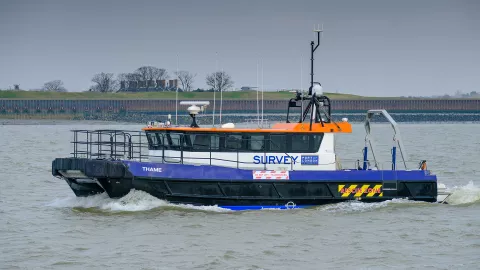
Initially built in 2012 by South Boats Special Projects as an offshore wind farm crew transfer boat, the vessel was bought by the PLA in 2017, converted for hydrographic use and renamed Thame.
Thame has an LOA of 14.2 meters, beam of 5.3 meters, draught of 0.8 meters and a lightship displacement of 14 tons. Powered by twin Caterpillar C9 ACERT 510mhp diesel engines, coupled to Hamilton HJ364 water jet which make the vessel highly manoeuvrable and suited for surveying on the busy waterways of the Thames.
The surveying suite installed on the vessel includes a high resolution Multibeam Echosounder System, vessel based LiDAR, A-Frame and winches to support the range of survey tasks undertaken by the busy PLA Hydrographic Service, including support of safety of navigation charting, dredge support, marine asset inspections, geophysical and geotechnical investigations both for the PLA and its commercial clients.
Galloper
In March 2008 the hydrographic department took delivery of a new shallow drafted catamaran, Galloper from the Cheetah Marine yard on the Isle of Wight.
The vessel has a shallow draft of 30cms and a moonpool for deployment of Multibeam equipment. Allied with twin Honda 135hp outboard engines, this configuration will enable speeds of up to 30 knots, thus maximising time on site and acquisition time which can be crucial when surveying busy ports or tidally-constrained waters.
Tamesis

Acquired in 2023, Tamesis is a USV (Uncrewed Survey Vessel), specifically a Maritime Robotics Otter, maintained and operated by PLA Hydro.
Tamesis supports MSC and PhD training, PLA survey work and various other projects. This fully electric, remotely operated survey platform is equipped with a Multibeam system and can be fitted with a vessel-based LiDAR system. The 2m vessel is ideal for shallow water and restricted access surveys and is transported in a dedicated, fully electric van—making it a highly sustainable survey option.
Pilot cutters
Pilot cutters are used to take pilots between the four pilot stations (at Gravesend, Harwich, Sheerness and Ramsgate) and ships entering or leaving the Port of London.
Two dedicated pilot cutters Guide and Leader are based at Gravesend. The six cutters used at Ramsgate are operated by a Estuary Services Limited, which is a subsidiary of the PLA.
PLA pilots based at Harwich use cutters operated by Harwich Haven Authority by arrangement.
Guide
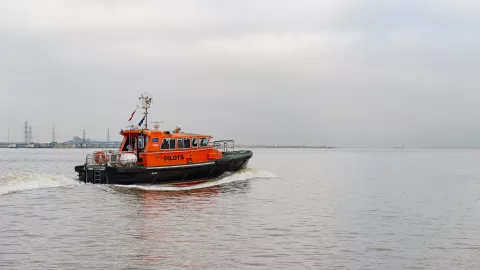
Guide, which was purchased from Estuary Services Limited in July 2018, was built in 1991 Halmatic 48/50.
With an overall length of 14.83m and a draught of 1.4m, she is powered by twin Caterpillar 3406E engines (550bhp @ 2100rpm) and has a maximum speed of 22 knots.
Leader
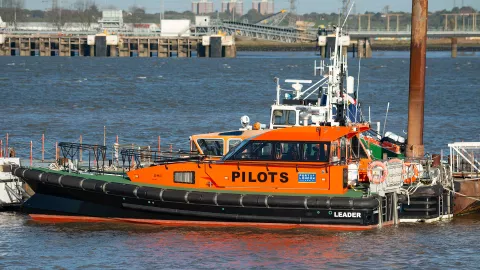
Leader was built in 2018 by Goodchild Marine and delivered in spring 2019.
Originally a plug-in diesel hybrid, the pilot boat's hull is based on the established ‘ORC’ design, a unique ‘beak’ bow design, which gives it unmatched all weather capability and typically uses 40% less diesel per nautical mile than convention hulls. Leader was retro-fitted in 2023 and now runs on renewable HVO diesel.
Discover



